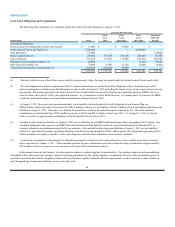Neiman Marcus 2012 Annual Report Download - page 32
Download and view the complete annual report
Please find page 32 of the 2012 Neiman Marcus annual report below. You can navigate through the pages in the report by either clicking on the pages listed below, or by using the keyword search tool below to find specific information within the annual report.
Table of Contents
One). Pursuant to an agreement with Capital One, which we refer to as the Program Agreement, Capital One currently offers credit cards and non-card
payment plans.
Pursuant to the Program Agreement, we receive payments (Program Income) from Capital One based on sales transacted on our proprietary credit
cards. We recognize Program Income when earned. In the future, the Program Income may:
· increase or decrease based upon the level of utilization of our proprietary credit cards by our customers;
· increase or decrease based upon the overall profitability and performance of the credit card portfolio due to the level of bad debts incurred or
changes in interest rates, among other factors;
· increase or decrease based upon future changes to our historical credit card program in response to changes in regulatory requirements or other
changes related to, among other things, the interest rates applied to unpaid balances and the assessment of late fees; and
· decrease based upon the level of future services we provide to Capital One.
Seasonality
We conduct our selling activities in two primary selling seasons—Fall and Spring. The Fall season is comprised of our first and second fiscal
quarters and the Spring season is comprised of our third and fourth fiscal quarters.
Our first fiscal quarter is generally characterized by a higher level of full-price sales with a focus on the initial introduction of Fall season fashions.
Aggressive marketing activities designed to stimulate customer purchases, a lower level of markdowns and higher margins are characteristic of this quarter.
The second fiscal quarter is more focused on promotional activities related to the December holiday season, the early introduction of resort season collections
from certain designers and the sale of Fall season goods on a marked down basis. As a result, margins are typically lower in the second fiscal quarter.
However, due to the seasonal increase in revenues that occurs during the holiday season, the second fiscal quarter is typically the quarter in which our
revenues are the highest and in which expenses as a percentage of revenues are the lowest. Our working capital requirements are also the greatest in the first and
second fiscal quarters as a result of higher seasonal requirements.
Our third fiscal quarter is generally characterized by a higher level of full-price sales with a focus on the initial introduction of Spring season
fashions. Aggressive marketing activities designed to stimulate customer purchases, a lower level of markdowns and higher margins are again characteristic of
this quarter. Revenues are generally the lowest in the fourth fiscal quarter with a focus on promotional activities offering Spring season goods to customers on a
marked down basis, resulting in lower margins during the quarter. Our working capital requirements are typically lower in the third and fourth fiscal quarters
compared to the other quarters.
A large percentage of our merchandise assortment, particularly in the apparel, fashion accessories and shoe categories, is ordered months in advance
of the introduction of such goods. For example, women’s apparel, men’s apparel, shoes and handbags are typically ordered six to nine months in advance of
the products being offered for sale while jewelry and other categories are typically ordered three to six months in advance. As a result, inherent in the successful
execution of our business plans is our ability both to predict the fashion trends that will be of interest to our customers and to anticipate future spending
patterns of our customer base.
We monitor the sales performance of our inventories throughout each season. We seek to order additional goods to supplement our original purchasing
decisions when the level of customer demand is higher than originally anticipated. However, in certain merchandise categories, particularly fashion apparel,
our ability to purchase additional goods can be limited. This can result in lost sales in the event of higher than anticipated demand for the fashion goods we
offer or a higher than anticipated level of consumer spending. Conversely, in the event we buy fashion goods that are not accepted by the customer or the level
of consumer spending is less than we anticipated, we typically incur a higher than anticipated level of markdowns, net of vendor allowances, resulting in
lower operating profits. We believe that the experience of our merchandising and selling organizations helps to minimize the inherent risk in predicting fashion
trends.
30
























